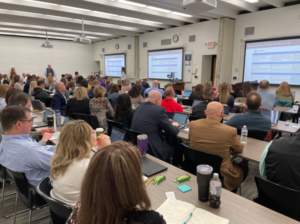A District Guide to Online Learning

Online learning can expand student (and staff) options, grow enrollment, and power blended learning. It shares many critical success factors with traditional education, but different enough that you need to do your homework and develop a good plan. Following is a 10 point district/network guide to online learning.
1. Clarify goals. You may want to:
- Expand advanced options including AP, dual enrollment, or advanced STEM courses;
- Expanding access to world languages (see paper on next-gen world language)
- Expand access to electives
- Add hard to staff courses and services (e.g., speech therapy)
- Remain competitive in a multi-provider environment; and
- Boost enrollment/revenue.
2. Get to know state policy.
- Read Keeping Pace profile
- See Digital Learning Now Report Card
3. Get/hire experienced help. Like traditional delivery, quality online starts with great teaching. However, offering a full catalog of online courses involves a range of new and different issues. Hire someone with experience teaching online and managing online and blended learning to lead the program.
4. Consider a partner. There are a handful of high capacity national partners that can provide turnkey support to an online learning program including: Connections Learning, Fuel Education (K12), and Florida Virtual. They all have experience helping districts implement online learning programs.
5. Pick a platform and content. If you don’t rely on a partner, you’ll need to pick a learning management system and content. There are a couple learning management systems (LMS) that are widely used to support online and blended learning including Canvas by Instructure, and Brainhoney and Buzz by Agilix. Some providers, including Apex, Compass Learning, and Edgenuity, provide content and an LMS.
Open content is worth considering especially for blended environments. Because most of it is modular (rather than courseware), it may require more planning and coordination by teachers.
6. Leverage online capacity to blend traditional schools. You may be able to use the same LMS and content catalog to power 6-12 blended classrooms. AdvancePath and Cornerstone Charter Schools use Apex content to power blended high school classrooms. Michigan’s EEA uses CompassLearning Odyssey across its 12 school network. (See What’s All The Buzz About Detroit?)
7. Staffing. For the subjects where you can generate more than 150 enrollments and where you have or can find the people, you can staff course delivery yourself. In harder to staff and smaller demand classes, rely on your partner to staff the class.
You may want to consider moving all your small upper division AP courses online and adding the rest of the AP courses to the catalog. This is also a chance to add more foreign languages options. This may be an opportunity to save money, add options, and invest in important 9th and 10th grade classes.
8. Provide guidance on self-blends. Now that you can offer a broader course catalog, it’s important to provide guidance to students starting in eighth grade about online high school options.
Consider making an online class a graduation requirement. Most students will be learning online when they leave high school whether it’s in the military, corporate training, or college.
9. Marketing. You’ll probably be competing regionally for students so you’ll need to develop a marketing and recruiting strategy (inside and outside the district) to build enrollment. What makes your offering distinctive? Can you offer onsite support—scheduled and drop in?
10. Budget. Now it’s time to build a budget. If you plan to offer some classes yourself, you’ll want six months to plan, hire and train staff; and do some marketing. Be prepared to lose money for a year if enrollment doesn’t meet your expectations. Working with a national partner is a good way to share the enrollment risk and development cost.
If you’re still interested in starting an online learning program, the next step is iNACOL’s How to Start an Online Learning Program.
For more see these papers:
- Online Learning: Myths, Reality & Promise
- Fueling a Personalized Learning Revolution
- Core & More: Guiding and Personalizing College & Career Readiness
Update of a May 2013 post. Disclosures: Agilix, Digital Learning Now!, K12, Connections, FuelEd, Instructure, Florida Virtual, and Compass Learning are Getting Smart Advocacy Partners. Tom is a director of iNACOL.








0 Comments
Leave a Comment
Your email address will not be published. All fields are required.